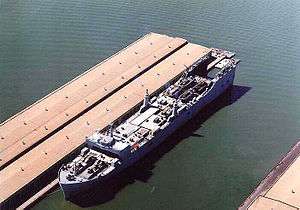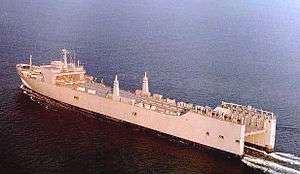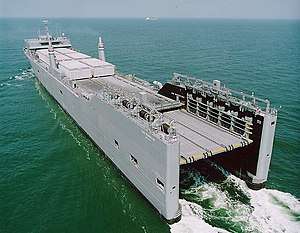Lighter aboard ship
The lighter aboard ship (LASH) system refers to the practice of loading barges (lighters) aboard a bigger vessel for transport. It was developed in response to a need to transport lighters, a type of (usually but not always) unpowered barge, between inland waterways separated by open seas. Lighters are typically towed or pushed around harbors, canals or rivers and cannot be relocated under their own power. The carrier ships are known variously as LASH carriers, barge carriers, kangaroo ships or lighter transport ships.[1]
Development
By the 1950s, the needs of cargo transport customers were no longer being met by the break bulk system of loading individual cargo pieces into a ship's hold. The dimensions and shapes of cargo pieces varied widely, and the ISO standard cargo container had only slowly begun to be adopted during the 1960s. Large container terminals with extensive conveyor systems and storage areas were still only in planning or in the development stages.
The LASH system was developed as an alternative and supplement to the developing container system. The lighters, which may be characterized as floating cargo containers, served dual purposes: transportation over water, and the establishment of a modular, standardized shape for loading and unloading cargo. The lighters, also known as swimming normed cargo containers, are loaded onto a LASH carrier at the port of embarkation and unloaded from the ship at the port of destination.
The system was developed during the 1960s by the American shipbuilding engineer Jerome Goldman. Acadia Forest, commissioned in September 1969, was the first LASH carrier - the ship could take up 75 standardized lighters, with about 376 metric tons of total loading capacity. At the time, it was a novel kind of ship, the first vessel designed primarily to transport other, smaller ships.
In the late 1980s, the Soviet Union built Sevmorput, a nuclear-powered LASH carrier. Sevmorput was one of only four nuclear powered cargo vessels ever built, the largest and the only one in an active commercial service, as it mainly operates in the Russian domestic waters along the Northern Sea Route, where it's unencumbered by the ports' unwillingness to accommodate nuclear ships, a problem that made other nuclear cargo vessels impractical.
Economic impact
At the time of its invention, the system was considered by experts to be a considerable advancement in shipping technology. LASH carriers were able to transport five times more cargo than a comparable conventional transport ship, the loading and unloading process was much more efficient, and a lack of harbor equipment or quay moorings provided no obstacle, as the lighters could be loaded directly onto the ship. The system also relieved the pressure to unload as quickly as possible, since the lighters already in the water could be moved while others were being unloaded. All told, these ships spent more than 80% of their annual application time at sea, whereas the conventional ships often lay at harbor for as much as half the year.
Technology
LASH barges are loaded at inland river and shallow ports. Then, the barges are towed to ocean port's fleeting areas to meet the LASH mother vessel. On arrival, the mother vessel crane lifts the LASH barges onto the ships. LASH cargo does not require transshipment, as the movement from the origin to destination takes place with a single bill of lading.
An important technical problem raised by the invention of the new transport system was the shape of the lighters. Several other designs, differentiated mainly by the shape of the lighters and the loading mechanism, were proposed, but the LASH system found the largest range of applications. In this approach, the lighters were individually lifted onto the carrier ship by a large crane located at the stern of the ship. The crane could move the entire length of the ship and stack the lighters atop each other in the ship's body and on the deck. The cranes had a load-carrying capacity of more than 500 Mp. Loading or unloading a lighter took on average fifteen minutes. LASH ships were constructed in Europe, Japan and the USA with almost uniform parameters.
The host vessel is sometimes purpose-built or modified with a door at the waterline, to allow the payloads to be loaded and unloaded without special lifting equipment. An example would be LASH Turkiye, built at Avondale Shipyard for the American shipping line Prudential Grace, and later transferred to the Ready Reserve Fleet.[2]
Technical data

| Type of Carrier | LASH 1 | LASH2 | |
|---|---|---|---|
| Overall length | m | 262 | 250 |
| Beam | m | 32.50 | 30.50 |
| Draught | m | 11.30 | 10.70 |
| Tonnage | tons | 43000 | 29600 |
| Speed | knots | 19 | 22 |
| Power | hp | 26000 | 32000 |
| Type of Lighter | |
|---|---|
| Length | 18.70 m |
| Beam | 9.50 m |
| Headway | 4.00 m |
| Weight | 80.00 tonnes |
| Capacity | 380.00 tonnes |
| Draught | 2.60 m |
Sea Bee system



Another related system was the Sea Bee, which had a lifting system located at the stern of the carrier ship, known as Type C8-class ship. The lift, known as a "Syncrolift" was a platform that could be lowered below the water surface. Two lighters weighing up to 1,000 metric tons are maneuvered onto the now-underwater platform and raised to the height of the deck, where special rails engage and transport the lighters down the length of the ship to their berthings. The lighters used in the Sea Bee system are considerably larger than the LASH lighter, and the loading hardware is also stronger, with a lifting force of more than 2,000 Mp.
The first ship of a series of three Sea Bee ships was SS Doctor Lykes, followed by SS Almeria Lykes and SS Tillie Lykes all of which were operated by Lykes Brothers Steamship Company. The "Sea Bee" vessels had three decks and could transport 38 lighters (12 on the lower decks and 14 on the upper deck). The dual function of the ship is noteworthy, as it had storage tanks with a capacity of nearly 36000 m³ volume built into its sides and the unusually large double hull, allowing it to be used also as a product tanker. The ships were later purchased by Military Sealift Command.
Finnish state-owned shipbuilding company Valmet built two barge carriers largely based on the Sea Bee system for the Soviet Union in Vuosaari Shipyard in the late 1970s, Yulius Fuchik and Tibor Szamueli. Of these, Yulius Fuchik was featured in a prominent role in the novel Red Storm Rising by Tom Clancy, where it was modified to masquerade as Doctor Lykes.
Technical data
| Seabee-Carrier | ||
|---|---|---|
| Overall length | m | 266.70 |
| Beam | m | 32.26 |
| Height to the first deck | m | 9.70 |
| Height to the main deck | m | 16.10 |
| Height to the upper deck | m | 22.80 |
| Draught | m | 10.00 |
| Capacity | tons | 27500 |
| Displacement | tons | 45400 |
| Speed | knots | 20 |
| Power | hp | 36000 |
| Seabee-Lighter | ||
|---|---|---|
| Length | m | 29.75 |
| Beam | m | 10.67 |
| Headway | m | 3.80 |
| Weight | tonnes | 150 |
| Capacity | tonnes | 850 |
| Draught | m | 3.25 |
BACAT system
A Danish project with the name BACAT (Barge-Catamaran) was introduced at the end of 1973. It was used for the transport of several hundred thousand metric tons of load between northern Europe and Great Britain. The system was similar to the Sea Bee, but the lighters were smaller and had an individual load-carrying capacity of only 140 tons.
Technical data
| BACAT-Carrier | ||
|---|---|---|
| Overall length | m | 103.50 |
| Beam | m | 20.70 |
| Headway | m | 10.50 |
| Draught | m | 5.40 |
| Capacity | tons | 2700 |
| Speed | knots | 13 |
| Power | hp | 2250 |
| Lighter type 1 | Lighter type 2 | ||
|---|---|---|---|
| Length | m | 16.80 | 18.75 |
| Beam | m | 4.70 | 9.50 |
| Draught | m | 2.47 | 2.50 |
| Capacity | tonnes | 140 | 370 |
Problems and shortcomings
New problems which were as yet unknown to shipping companies arose with the advent of the LASH system and similar barge carriers. Aboard the carrier ship, the lighter is simply a large cargo container, but in the seaport and on the inland waterways it becomes a vessel. As a vessel, they are subject to requirements for equipment regulations like anchors, winches, coupling had to be provided so-called "head barges" which could not be transported on the carrier ships. Also, serving waterways which freeze over in winter required a high capital expenditure.
Studies showed that the costs of addressing these issues, along with the costs of operating the carrier ships and their lighters, were much higher than for the customary freighter ships or the ISO-compliant container ships that were beginning to conquer the transportation market. While barge carriers and lighters are a technologically interesting sea transport system, they are economic only under certain specific conditions of traffic and economy.[3]
History
On 15 December 2007, Rhine Forest,[4] ex-Bilderdijk of the Holland-Amerika Line, entered the Port of Rotterdam for the last time, prior to being withdrawn from service because of low utilization on the New Orleans/Rotterdam route. It is a sister ship of MS München. The LASH lighter with registration p. CG 6013 was donated to De Binnenvaart, an inland-shipping museum in Dordrecht, where it is now part of an exhibit.
See also
Notes
References
- Jahrbuch der Schiffahrt 1974 Schiffe im Schiff (Float on / Floot of) TRANSPRESS Berlin 1973 (in German)